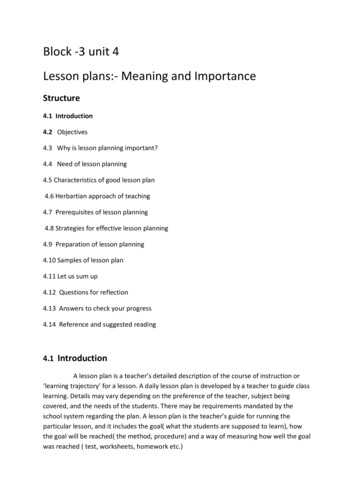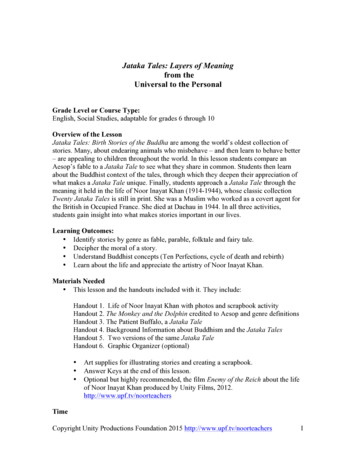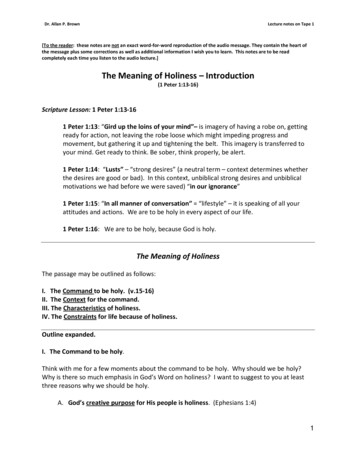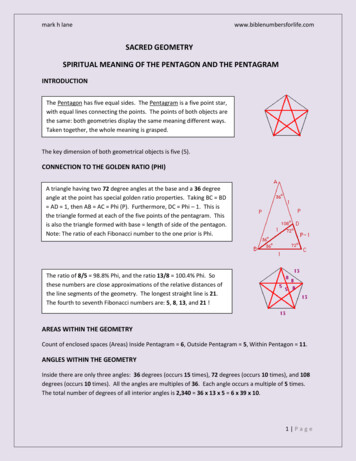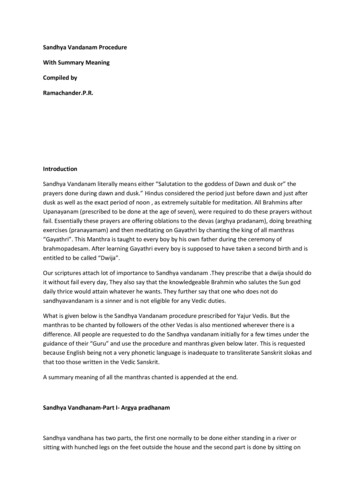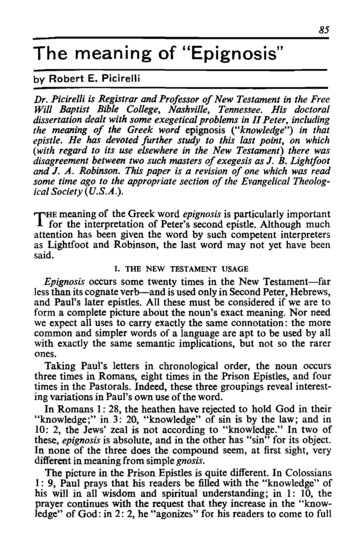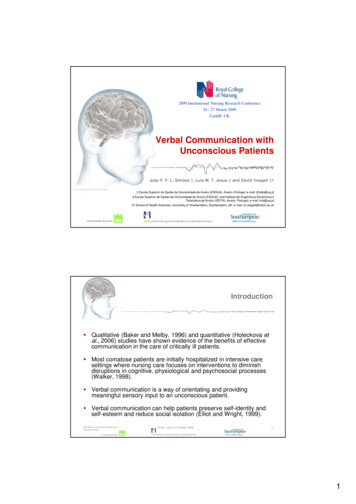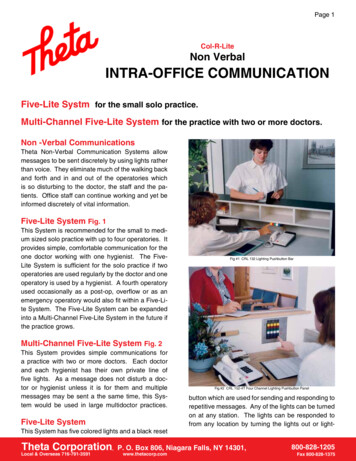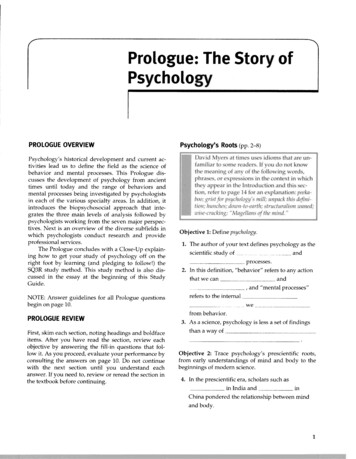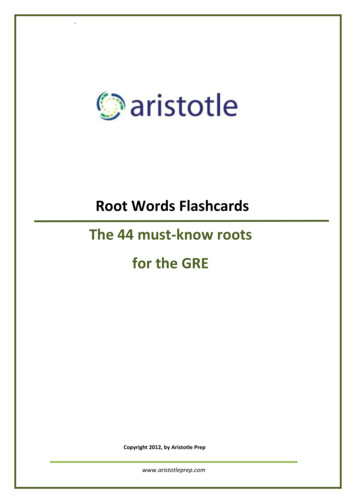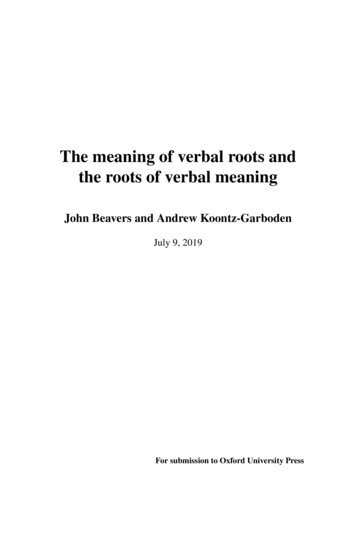
Transcription
The meaning of verbal roots andthe roots of verbal meaningJohn Beavers and Andrew Koontz-GarbodenJuly 9, 2019For submission to Oxford University Press
ContentsAcknowledgmentsviiAbbreviations usedxiGlossing conventionsxiii1 Introduction11.1 Lexical semantics and theories of verb meaning 11.2 Thematic roles as a theory of verb meaning 61.3 Event structures as a theory of verb meaning 91.3.11.3.21.3.3Roots, templates, and decompositional structuralA semantics for event structures 13Summary: The core properties of event structures91.4Hypotheses about root meaning1.4.11.4.21.4.31.4.4The Bifuraction Thesis of Roots 27Manner/Result Complementarity 28The true distinction between roots and templatesComparison to prior works 321.51.6Outline of the study34Background assumptions: Defining causation and change1.6.11.6.2Change of state as scalar change 36Causation and its role in verb meaning222429492 Entailments of change in the roots of change-of-state verbs2.1 Two types of change-of-state verbs572.2 Lexical semantic consequences of Bifurcation 602.2.1Three semantic predictions62iii3657
iv / T HE MEANING OF VERBAL ROOTS AND THE ROOTS OF VERBAL MEANING2.2.22.2.32.2.4Entailments of change in derived statives 68Sources of variation 71Summary: Predictions of Bifurcation and semantic explananda2.3Morphological consequences of Bifurcation2.3.12.3.22.3.3Four morphological predictions 74Adjectives derived from the different root classes across languages 76Summary: Predictions of Bifurcation and morphological explananda 802.4Analytical option 1: Abandon Bifurcation2.4.12.4.22.4.32.4.4A purely non-lexicalist analysis 80A purely lexicalist analysis 90A mixed analysis 94Summary 952.5Analytical option 2: Preserving Bifurcation2.5.12.5.22.5.32.5.4Reanalyzing result roots as manner entailing 96Allosemy 98Root selection for syntactic construction 102Summary 1032.62.7Roots vs. templates in change-of-state verbsConcluding remarks104737480961043 The roots of ditransitive verbs of caused possession1073.1 Roots and templates in ditransitive verbs 1073.2 Ditransitive verbs, possession, and co-location 1113.3 The meanings of the templates: A case for root sensitivity 1153.3.1 The semantics of indirect object templates3.3.2 The semantics of to templates 1173.3.3 Summary 1201153.43.53.6Change of state and aspectual properties: Root telicityDefining and composing template and root meaningsRoot classes1301221243.6.13.6.23.6.33.6.43.6.53.6.6True possession roots 130Release roots 135Arrival roots 138Electronic release and arrival rootsFuture having roots 140Summary 1413.73.8Further evidence for change-of-state in roots: Root durativity 142The Dative Alternation: Root-determined argument realization 148139
C ONTENTS / v3.9 Alternative analyses: Allosemy and allomorphy3.10 Root vs. template in ditransitive verbs1553.11 Concluding remarks1571504Manner/Result Complementarity and causation in verbalroots1594.1 Manner/Result Complementarity1594.2 Result entailments in verbs1654.2.14.2.24.2.3Result diagnostic # 1: Denial of result 166Result diagnostic # 2: Object deletion 168Result diagnostic # 3: Restricted resultatives4.3Manner entailments in verbs4.3.14.3.24.3.3Manner diagnostic # 1: Selectional restrictions 173Manner diagnostic # 2: Denial of action 175Manner diagnostic # 3: Complexity of action 1774.4Classes of manner result verbs4.4.14.4.24.4.34.4.4Manner of killing verbs 179Manner of cooking verbs 183Ditransitive ballistic motion verbsSummary of manner result verbs4.5Manner, result, and the architecture of event structure4.5.14.5.24.5.34.5.44.5.5Complementarity in event structures 191The decomposition of transitive manner result predicates 194Roots of transitive manner result verbs as complements of v 199Roots of ditransitive manner result verbs as adjuncts of v 202A typology of the roots of manner result verbs 2044.64.74.8The roots of manner result verbs and BifurcationRoots vs. templates in manner result verbs 208Concluding remarks2091691721781871895 Conclusion2115.1 Summary on conditions on root meaning 2115.2 The origins of complex root meanings2135.2.15.2.25.2.3Networks of lexical entailments 214Lexicalized conventional associations 220Summary 2225.35.4Are there any constraints on root meaning?Possible and impossible verbs2255.4.15.4.2A typology of roots 225A theory of possible verb classes5.5Concluding remarks and outlook230232222205191
vi / T HE MEANING OF VERBAL ROOTS AND THE ROOTS OF VERBAL MEANINGReferences233
AcknowledgmentsThis book is about word meanings, especially the meanings of verbs. It iswidely acknowledged that verb meanings have underlying structure, usuallyconsisting of some fairly general, regular meaning components like causeand change that occur across lots of verbs — the verb’s event template —plus some verb-specific idiosyncrasy — the verb’s idiosyncratic root. Whilea considerable amount of work has been devoted to fleshing out the meaningsof event templates, less work has focused on the meanings of the idiosyncratic roots that make every verb different, and what kinds of patterns andregularities may be found there. Our goal is to address this question head on.Although the results here are fairly new, they are rooted in several strandsof research which date back nearly two decades. The semantics and morphology of change-of-state verbs and stative forms has been a long term focusof Andrew’s, while the semantics and argument structure of change-of-stateverbs and ditransitives has been a long term focus of John’s. These interestswere first merged in our initial work on Manner/Result Complementary, i.e.the question of whether a root ever describes both a result and the manner bywhich the result comes about at the same time. During that collaboration werealized we had each also been independently working within our own casestudies on the question of whether roots ever give rise to templatic meanings,i.e. the question of whether root and template meanings are bifurcated. Thisdiscovery lead us to ultimately bring all of these strands of work together intothe project that gave rise to this book.Given how long these projects have developed, in both cases going backto our graduate school days, it is almost impossible to ensure that we acknowledge everyone who has given us feedback along the way. We can saywithout a doubt that we owe an especial debt of gratitude to Beth Levin. Theorigins of Chapter 2 ultimately lie in a research assistantship Andrew held inhis formative graduate school years under Beth, funded by a National Science Foundation grant (BCS-0004437) awarded to her, which led to Koontzvii
viii / T HE MEANING OF VERBAL ROOTS AND THE ROOTS OF VERBAL MEANINGGarboden and Levin (2005) and ultimately to work in that chapter and relatedwork. More broadly, Beth has offered extensive feedback and guidance overthe years on the various projects tied together in this book (and others), andhas more generally served as an inspiration through her own groundbreakingresearch program, much of it in conjunction with Malka Rappaport Hovav.Their work has helped define the parameters of the field of lexical semanticsthat we have been working within for most of our careers and has opened upsome of the specific questions we address here. We are also enormously grateful to Malka as well for her support and extensive commentary and back andforth on the work presented here and related projects over the years, whichhas been inspiring and helped us sharpen our ideas.We are also of course grateful to the many people who have given us feedback on this manuscript during its development. This includes the detailedand enormously helpful feedback of three anonymous reviewers of parts ofthis manuscript, plus the various reviewers of related papers this book drawsfrom and builds on. This material is based upon work supported by the National Science Foundation under grant no. BCS-1451765. We have benefitedgreatly from extensive discussion with our various project collaborators, including in particular Michael Everdell, Kyle Jerro, Henri Kauhanen, EliseLeBovidge, Stephen Nichols, and Daniel Valle. Special thanks are also dueto Ashwini Deo and Itamar Francez for their long term feedback on a varietyof issues related to the work here.We would also like to offer our thanks to various others we’ve been fortunate to discuss these ideas with, including Luke Adamson, Artemis Alexiadou, Daniel Altshuler, Elena Anagnostopoulou, Nick Asher, Josep Ausensi,Asaf Bachrach, Larry Barsalou, David Basillico, Sergio De Moura Menuzzi,David Beaver, Delia Bentley, Ricardo Bermúdez-Otero, Nora Boneh, JonathanBobaljik, Jurgen Bohnemeyer, Olly Bond, Hagit Borer, Alex Brown, Benjamin Bruening, Ray Buchanan, Lucas Champollion, Beaudry Chase, LizCoppock, David Embick, Hana Filip, Jens Fleischhauer, Bob Frank, JosepFontana, Thomas Gamerschlag, Nikki Grant, Heidi Harley, Elena Herberger,Matthew E. Husband, Larry Horn, Ray Jackendoff, E Jamieson, Hans Kamp,Itamar Kastner, Éva Kardos, Graham Katz, Justin Kelly, Chris Kennedy,Paul Kiparsky, Hans van de Koot, Lissa Krawczyk, Jean-Pierre Koenig,Paul Kroeger, Jacques Lafleur, Lisa Levinson, Alec Marantz, Fabienne Martin, Jaume Mateu, Louise McNally, Richard Meier, Victor Mena, LauraMichalis, Ad Neeleman, Andrew Nevins, Johanna Nichols, Tatiana Nikitina,Vitor Nóbrega, Rick Nouwen, Rainer Osswald, Peter Petré, Colin Phillips,Paul Portner, Tillmann Pross, Geoff Pullum, James Pustejovsky, GyörgyRákosi, Gillian Ramchand, Kyle Rawlins, Hannah Rohde, Ivan Sag, Helen Salgi, Florian Schaefer, Jesse Snedecker, Giorgos Spathas, Scott Spicer,Eduardo Soares, Mark Steedman, Peter Svenonius, Alex Teodorescu, Shiao
ACKNOWLEDGMENTS / ixWei Tham, Lindia Tjuatja, Judith Tonhauser, Christina Tortora, Elly vanGelderen, Robert Van Valin, Sarah Van Wagenen, Klaus von Heusinger, Bonnie Webber, Steve Wechsler, Annie Zaenen, Julia Zinova, Cala Zubair, andJoost Zwarts, among many others.We are also grateful for the audiences at the 2004, 2006, and 2017 Linguistic Society of America Annual Meetings, the 2006 meeting of the BerkeleyLinguistic Society, SemFest 2009, the 2009 Stuttgart Roots Workshop, the2009, 2010 and 2018 meetings of Linguistic Association of Great Britain, the2010 meeting of the Georgetown Linguistics Society, Verb Meaning, EventSemantics and Argument Structure 2010, Structuring the Argument 2011,The 5th International Conference on the Linguistics of Contemporary English, Concept Types and Frame 2012, the Roots IV Workshop held at NewYork University in 2015, The University of Texas at Arlington Student Conference in Linguistics and TESOL 2015, the 2016 West Coast Conference onFormal Linguistics, The Society for the Study of the Indigenous Languagesof the Americas 2017, Beyond Time 2017, Endpoints 2018, Sinn und Bedeutung 2018, and University of Debrecen, University of Düsseldorf, University of California at Berkeley, University of Göttingen, Universitat PompeuFabra, University of Newcastle, and The University of Edinburgh. We likewise thank the participants in Andrew’s 2007-2014 Grammatical semanticsclasses and his 2015 Linguistic Society of America Summer Institute courseon Approaches to Morphosemantics, and John’s The Roots of Verb Meaningcourse at the 2014 Workshop on Formal Linguistics X at Universidade Federal do Rio Grande do Sul in Porto Alegre, Brazil, 2015 Lexical SemanticsSeminar at The University of Texas at Austin, and 2015 Linguistic Societyof America Summer Institute course on Lexical Semantics at University ofChicago, plus the participants in the University of Texas syntax/semanticsresearch group.We also owe a special thanks to Julia Steer for her help in making this booka reality, as well as David Adger and Hagit Borer, and also Vicki Suntnerfor helpful feedback on the manuscript. Thanks also to Michael YoshitakaErlewine for some crucial help with LATEX.Chapter 3 is a revised and expanded version of Beavers and KoontzGarboden (2012), originally published in Linguistic Inquiry. We are gratefulto The University of Texas Graduate School for support on John’s initial workon ditransitives (Beavers 2011a) that later fed this project, The University ofTexas College of Liberal Arts for support during the preparation of the initialdraft of the full manuscript, and the University of Manchester School of Arts,Languages, and Cultures, for funding several crucial work meet ups.Special thanks are due to Dylan Bumford, Paul DeMello, Kaan Erdener,Shalini Gupta, Damien Harris, Joe McElrath, Chris Micklethwait, Mindy Nobles, Nick Rundquist, Danny Tobey, Judith Tobey, Ted Tran, Juan Valdez, and
x / T HE MEANING OF VERBAL ROOTS AND THE ROOTS OF VERBAL MEANINGvarious others for their judgments and (sometimes lively) discussion of various aspects of the data here and in related projects. Special thanks are alsodue to Ernest Skočdopole in particular for help with zombies, to Nikki Norman Briscoe, Jennifer Davis, and Jason Cammack for the memory jogs, toeveryone at The Railway, Dunham Massey Brewing Co, and CherrywoodCoffeehouse, and to that random guy in Stuttgart who took us to all thosedance clubs in the middle of the night back in 2009.Finally, our greatest debt of gratitude is of course to Janice, Morrissey,Ezra, Mindy, Melissa, Heath, Blaine, and Lola for all of their dedication andsupport, and especially for their tolerance for multiple, extended internationalwork trips, frequent lapses in attention while we were attending to writing,and the occasional noisy late night work sessions that we hope didn’t keepeveryone up too much. We could not have completed this project withoutthem.
Abbreviations XPArgumentAdjectiveAdjective PhraseAspectAspect PhraseChange of StateDeterminer phraseFigure/Path RelationIntransitiveTransitiveLogical FormPrepositionProperty ConceptPhonetic FormPrepositional PhraseTenseTense PhraseLight VerbLight Verb PhraseVerbVerb PhraseX Phrasexi
Glossing c
2.6 Roots vs. templates in change-of-state verbs 104 2.7 Concluding remarks 104 3 The roots of ditransitive verbs of caused possession 107 3.1 Roots and templates in ditransitive verbs 107 3.2 Ditransitive verbs, possession, and co-location 111 3.3 The meanings of the templates: A case for root sensitivity 115 3.3.1 The semantics of indirect object templates 115 3.3.2 The semantics of to .
